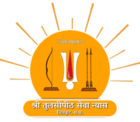Mūlārthabodhinī – मूलार्थबोधिनी
Book release programme details: Name of book: श्रीभक्तमाल (मूलार्थबोधिनी टीका सहित) {Śrībhaktamāla (with the Mūlārthabodhinī commentary)} Author: Gurudeva (Jagadguru Rāmānandācārya Svāmī Rāmabhadrācārya) Date: Tuesday, January 14 2014Time: Between 4:30 PM and 6:30 PM ISTVenue: Ramlila Madian, Ghaziabad, Uttar PradeshCoverage: Live on Sanskar TVDignitaries to be present: Śrīrājendradāsajī Mahārāja (Jagadguru Dvārācārya Malūkapīṭhādhīśvara), Śrīkṛṣṇacandrajī Śāstrī Ṭhākura (Bhāgavatabhāskara), Śrīśyāmasundara Pārāśara (Bhāgavata Kathāvācaka), Śrīdevakīnandana Ṭhākurajī Mahārāja (Śāntidūta), Śrīpremabhūṣaṇajī Mahārāja (Premamūrti), Mahanta Śrīnārāyaṇagirijī (Mahāmantrī, Bhārata Sādhu Samāja) Mūlārthabodhinī is a small commentary in around 55,000 words on the original verses of the Śrībhaktamāla of Nābhājī. The commentary was composed by Gurudeva in December 2013 in only fifteen hours. The work was dictated over eight sessions between December 16 and December 23. The work was typed, proofread and typeset in ten days by volunteers of Śrītulasīpīṭha Sevā Nyāsa, and the first edition was printed for release on Makara Saṁkrānti VS 2070 (January 14 2014). Śrībhaktamāla or simply Bhaktamāla (literally, “The garland of devotees”) is a celebrated classic in the medieval Indian literature. It was composed by Gosvāmī Nārāyaṇadāsa (also known as Nābhājī), a contemporary of Gosvāmī Tulasīdāsa, sometime around the year 1600 CE. Bhaktamāla was composed in the Kāvyabhāṣā language (a hybrid of Braja and Awadhi) with the poet showing a greater use of Braja words. The work consists of 214 verses (17 Dohās, one Kuṇḍaliyā and 196 Chappayas) which sing the glory of Bhaktas (devotees) in an inclusive and liberal context – spanning across Yugas, geographies, languages, genders, castes, social strata, and religious sects. Nābhājī is considered to be the master of Chappaya metre; he is to the Chappaya what Bihārī is to the Dohā and Tulasīdāsa is to the Caupaīi. With the Bhaktamāla of Nābhājī, a new genre started in the Bhāṣā literature of India – the Bhaktamāla genre – many more Bhaktamālas were later composed by poets from different sects. Starting with the commentary Bhaktirasabodhinī (c. 1712) of Priyādāsa, the Bhaktamāla has been commented upon and expounded by scholars throughout the eighteenth, nineteenth and twentieth centuries. There have been translations and/or adaptations in many languages including Samskrita, Gujarati, Marathi, Bengali, English, Persian and Urdu. Interest in the Bhaktamāla continues to flourish in the twenty-first century both within India and abroad, examples being the special edition Bhaktamālāṅka published by Kalyāṇa (Gita Press) in 2012, and James P Hare’s doctoral thesis on Bhaktamāla submitted to the Columbia University in 2011. As he himself testifies in the Bhaktamāla, Nābhājī was a fourth-generation disciple of Ādya Rāmānandācārya with the Paramparā being Rāmānandācārya, Anantānanda, Kṛṣṇadāsa Payahārī, Agradāsa, and Nābhājī. As per traditional accounts, he was born without eyesight in a poor Brahmin family in Rajasthan, sometime in the later sixteenth century. He was left to fend for himself in a forest by his parents during a drought. Nābhājī was rescued by Agradāsa and Kīlhadāsa, who granted him vision and initiated him in the Virakta order of Rāmānandā. Nābhājī stayed for most of his life in Galta (near Jaipur) in Rajasthan, and composed the Bhaktamāla as per the orders of his Guru Agradāsa.जयति जगदघालं भग्नभक्ताधिजालं हरिजनगुणमालं जुष्टराजत्तमालम्।विभुविरुदविशालं प्रेमपीयूषपालं हरिहृदयरसालं भास्वरं भक्तमालम्॥
कोउ कहे भक्तमाल परम कठिन ग्रन्थ कोउ कहे भक्तमाल पंडित पछार है।कोउ कहे भक्तमाल सतत दुरूह वस्तु कोउ कहे भक्तमाल पंडित जीवमार है।कोउ कहे भक्तमाल संतनकी निधि दिव्य कोउ कहे भक्तमाल पंडित फटकार है।जगद्गुरु रामानन्दाचार्य रामभद्राचार्य कहें भक्तमाल भव्य पंडित शृंगार है॥
